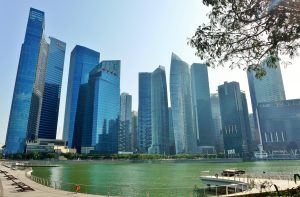An economic rebound widely expected in 2021 will lift most property sectors to some extent, in particular, the office, industrial and residential sectors
- An economic rebound widely expected in 2021 will lift most property sectors to some extent, in particular, the office, industrial and residential property sectors
- Pent-up demand for hotels driving a V-shape recovery by 2023
- Prime Office rents are set to increase by 5.5% and return to pre-COVID-19 level by the end of 2021
- Retail rents to remain flat with vacancy rates rising marginally to 8.9%
- Expect private land sales via en bloc and collective sales to recover
- Logistics rents to rise 1.3%, remaining one of investors’ preferred segments
- Investment sales to grow 20% to SGD29.7 billion and this will benefit property sectors
 Colliers International on 29 January published its Singapore Market Outlook 2021 report, which highlights trends, its growth forecasts for the market and the real estate opportunities in various property sectors in Singapore.
Colliers International on 29 January published its Singapore Market Outlook 2021 report, which highlights trends, its growth forecasts for the market and the real estate opportunities in various property sectors in Singapore.
Colliers Research reports identified three key themes driving the Singapore property market in a COVID-normal 2021. An economic rebound widely expected in 2021 will lift most property sectors to some extent, particularly the office, industrial and residential sectors.
Environment, Social and Governance (ESG) considerations will play an increasingly important role for both Occupiers and Investors when selecting a building. Finally, COVID-19 accentuated the need for flexibility in the pace, space, and place of work for occupiers, which should accelerate the traditionally mono-use CBD transformation to a mixed-use, 24/7 estate.
Ms Tricia Song, Head of Research for Singapore at Colliers International, said, “In 2021, we expect office, industrial and residential rentals to grow. Meanwhile, the retail rental market should remain flat, and hotels should see their first signs of recovery by Q4.”
Singapore Market Outlook 2020 Highlights
Hotel Property Outlook
As travel restrictions will remain in place for most of 2021, we forecast a pent-up demand driving a V-shape recovery by 2023. Colliers expects visitor arrivals and Revenue Per Available Room (RevPAR) to recover to 55% and 72% of pre-COVID levels, respectively by Q4 2021. Planned new attractions and infrastructure projects scheduled between 2021 and 2030, and the relatively tight supply pipeline underpin the sector’s long-run fundamentals.
Office Property Outlook
In 2021, Colliers Research expects office demand to continue to be led by the technology and the overall business recovery. With Occupiers needing more flexibility in the pace, space and place of work and placing more importance on sustainability, we see scope for older and less efficient CBD stock to be redeveloped into mixed-use and greener buildings. Few investors have already taken advantage of the set of incentives provided by URA to rejuvenate the CBD, and we foresee more to jump on the bandwagon.
Colliers forecasts Office rents to increase by 5.5% towards the end of 2021, as vacancy tightens to 5% from the 5.2% as of December 2020.
Retail Property Outlook
Retail was the second-worst performer with rents in the Central Region falling 14.7% in 2020, as lockdowns and safe distancing measures hurt retailer sales. Even as foot traffic and tenant sales have recovered to 60-97% of pre-pandemic levels by end-2020, Colliers Research expects an uneven recovery among trades, landlords to rejig tenant mix, and thus rents to remain flat with vacancy rates rising marginally to 8.9%.
This year’s key themes in the retail sector are relevance and transformation of Brick-and-Mortar retail; creation of lifestyle destinations and “Phygital” retail.
Residential Property Outlook
With strong developer sales and limited land sales in 2020, unsold private residential inventory has come off to 27,000 units, close to the 24,000 units, a trigger point for the collective sale back in 2017-2018. Developers’ hunger could be seen in the 15 bids for the last residential tender site, the highest number of bids since 2017. Colliers Research expects private land sales via en bloc and collective sales to recover in 2021.
We can also expect developers to incorporate technology, wellness and multi-functional elements in the home design.
Industrial Property Outlook
Logistics warehouses and data centres have risen in demand on accelerated e-commerce and cloud computing in 2020. We expect logistics rents to increase by 1.3% as logistics remains one of our preferred investor segments in 2021.
Given the very high energy consumption of data centres, the Singapore government has placed a moratorium on new construction until sustainability can be incorporated into their development.
Investment Sales Outlook
Investment sales in 2020 were boosted by REIT mergers. In 2021, Colliers Research anticipates investment sales to grow 20% to SGD29.7 billion, led by the commercial sector, on healthy fundamentals, a favourable interest rate outlook and Singapore’s status as a key gateway city.
Ms Tang Wei Leng, Managing Director at Colliers International, concluded, “2021 will be exciting as we already see some signs of recovery. Those who want to thrive this year will have to remain agile, flexible, sustainable and, most importantly, have to time it right. With every crisis comes opportunities and 2021 could be the year to seize them and get ahead of the game for both investors and occupiers.”
Mr Paul Ho, Chief Mortgage Officer at iCompareLoan, said: “The Covid-19 vaccine roll-out has given rise to some optimism regarding the overall economic growth for 2021. This coupled with the fact that Singapore is a safe place to park excess liquidity will mean that some property sectors may be lifted this year. But the office and industrial sectors will probably go through a period of deep reorganising or restructuring before their fortunes rise.”
One recent report said that the optimism around the vaccine roll-out is giving a push for the overall economic growth for 2021. The risk-on mode bodes well for the recovery in the investment sales market in 2021 as investors stand ready to deploy more capital in anticipation of growth and better returns in the new year. Given the prolonged low interest rate environment, investors who are flushed with liquidity will continue to look out for opportunities to acquire assets in search of higher returns.





